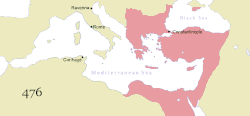
Back الإمبراطورية البيزنطية تحت حكم السلالة المقدونية Arabic Βυζαντινή Αυτοκρατορία υπό τη Δυναστεία των Μακεδόνων Greek Imperio bizantino bajo la dinastía macedonia Spanish امپراتوری بیزانس تحت دودمان مقدونیهای Persian Empire byzantin sous les Macédoniens French Kekaisaran Romawi Timur di bawah dinasti Makedonia ID Impero bizantino durante la dinastia macedone Italian Makedon Hanedanı döneminde Bizans İmparatorluğu Turkish مقدونیائی شاہی سلسلہ کے تحت بازنطینی سلطنت Urdu
Byzantine Empire
| |||||||||||||||||
|---|---|---|---|---|---|---|---|---|---|---|---|---|---|---|---|---|---|
| 867–1056 | |||||||||||||||||
 The Byzantine Empire at the death of Basil II, 1025 | |||||||||||||||||
| Capital | Constantinople | ||||||||||||||||
| Common languages | Medieval Greek,Old Albanian Romance languages, Armenian, Old Church Slavic, South Slavic languages, Syriac language | ||||||||||||||||
| Religion | Eastern Orthodox Church | ||||||||||||||||
| Government | Bureaucratic semi-elective monarchy | ||||||||||||||||
| Emperor | |||||||||||||||||
• 867–886 | Basil I | ||||||||||||||||
• 1055–1056 | Theodora Porphyrogenita | ||||||||||||||||
| History | |||||||||||||||||
• Murder of Michael III | 24 September 867 | ||||||||||||||||
• Death of Theodora Porphyrogenita | 31 August 1056 | ||||||||||||||||
| |||||||||||||||||
| History of the Byzantine Empire |
|---|
 |
| Preceding |
| Early period (330–717) |
| Middle period (717–1204) |
| Late period (1204–1453) |
| Timeline |
| By topic |
|
|
The Byzantine Empire under the Macedonian dynasty underwent a revival during the late 9th, 10th, and early 11th centuries. Under the Macedonian emperors, the empire gained control over the Adriatic Sea, Southern Italy, and all of the territory of the Tsar Samuil of Bulgaria. The Macedonian dynasty was characterised by a cultural revival in spheres such as philosophy and the arts, and has been dubbed the "Golden Age" of Byzantium.[1]
The cities of the empire expanded, and affluence spread across the provinces because of the newfound security. The population rose, and production increased, stimulating new demand for trade.
Culturally, there was considerable growth in education and learning (the "Macedonian Renaissance"). Ancient texts were preserved and recopied. Byzantine art flourished, and brilliant mosaics graced the interiors of the many new churches.[2]
Though the empire was much smaller than during the reign of Justinian, it was stronger, as its territories were both less dispersed and more politically and culturally integrated.[citation needed]
- ^ Browning, Robert (1992). The Byzantine Empire. Washington, DC: The Catholic University of America Press. p. 95. ISBN 978-0-8132-0754-4.
- ^ Norwich, John Julius (1998). A Short History of Byzantium. Penguin. ISBN 0-14-025960-0.